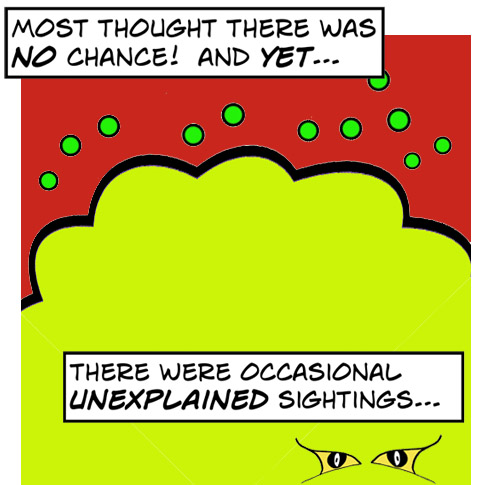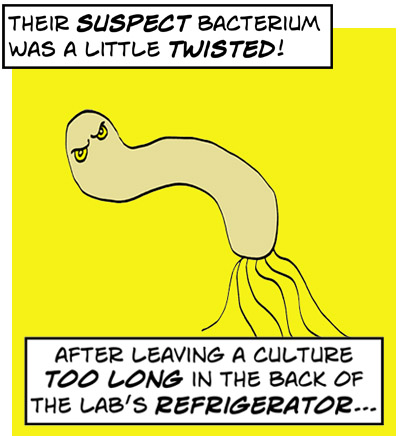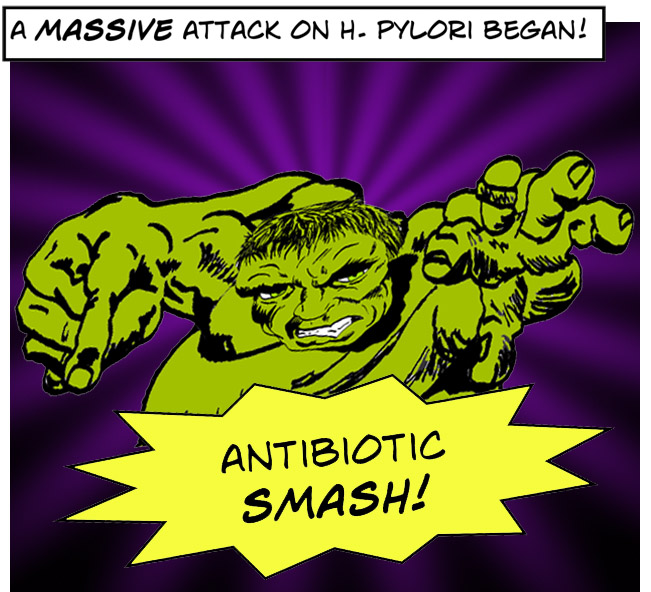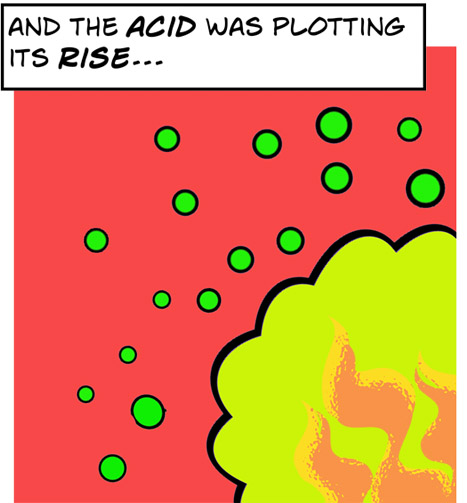Pylori Story #4: The Microbe Revolt
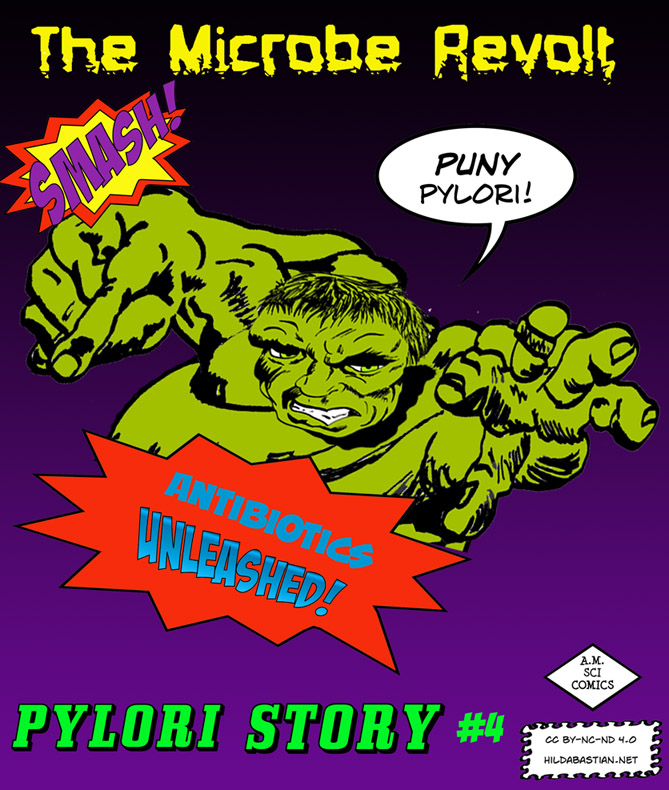 Could any life form survive in the stomach’s sizzling acid? Most thought there was no chance! And yet…there were occasional unexplained sightings…
Could any life form survive in the stomach’s sizzling acid? Most thought there was no chance! And yet…there were occasional unexplained sightings…
Click above for previous installments of Pylori Story.

Stomach ulcers are miserable things. And not just because of their symptoms. Some of them will perforate – burn their way right through the stomach wall, causing bleeding that can be life-threatening. And some will lead to stomach cancer.
Helicobacter pylori, or H. pylori, has been causing peptic and other stomach ulcers in people for thousands of years at least. The oldest specimen found so far was reported this week: from the stomach of a 5,300 year-old mummy. But we didn’t know it was the culprit for both peptic ulcers and a lot of stomach cancer until pathologist Robin Warren formed his strong suspicions about what he was seeing in specimens – and his colleague Barry Marshall decided to lay his own uninfected stomach on the line to find out once and for all (publishing in 1985).
H. pylori is a helix- or S-shaped and straw-colored bacterium with the extraordinary ability to resist being harmed by acid. It moves with a corkscrew motion, propelled by its flagella – the 5 to 7 string-like appendages at one end. (A general introduction here, and more technical detail here.)
An increase in H. pylori infection associated with urbanization probably helped an ulcer epidemic take hold in the early 20th century (in people born before 1950). High rates of smoking and large-scale use of painkillers really kicked it along. About 10% of people in developed countries had peptic ulcers at the height of the epidemic. And because there weren’t very effective drugs yet, about 10% of those had operations to remove a part (or even all) of all their stomachs – a whopping 1% of adults!
At times, we were wrestling directly with H. pylori even though we didn’t realize it. Bismuth salts, the basis for the widely used antacid Pepto Bismol, turned out to be helping partly because it reduced H. pylori populations. And H. pylori infection could make drugs that reduce acid secretion a little more effective. We went off on various tangents about the cause of stomach ulcers – especially about diet and stress. (Read more about belief in stress as the cause of stomach ulcers below Pylori Story #1: Acid Attack.)
For a while, H. pylori eradication was suspected as the reason for a rise in gastric esophageal reflux disease (GERD), but it doesn’t seem to be after all. Some also thought that H. pylori was the only bacterium that could survive in the stomach. In 2006, though, Elisabeth Bik and colleagues identified a vast variety of microbes in the lining of the stomachs of healthy people.
H. pylori infection isn’t increasing – about half the people on the planet are estimated to be infected by them, with more advantaged people being infected less. But the effectiveness of therapy has been declining as H. pylori resistance to antibiotics grows. A multicenter study by the CDC from 1998 to 2002 found that just under 30% of the isolates of H. pylori they studied were resistant to at least 1 antibiotic – and 5% were resistant to 2 or more.
But now, studies of H. pylori isolates are showing around 70% of them are resistant to at least 1 antibiotic. And a recent study in Turkey found that nearly 20% of isolates there were resistant to multiple antibiotics. Resistance is developing more quickly in drugs used heavily in the region. For example, a recent study in Italy found around 70% resistance to clarithromycin, while in China, a study found a similar level,but to metronizadole.
So far, the rate of death from bleeding ulcers hasn’t been increasing along with the rise of antibiotic resistance. Combinations of drugs are still working though.
Read more about the weird and wonderful history of viewing the inside of the stomach in Pylori Story #2: Journey to the Center of the Stomach – with a detailed timeline below.
Pylori Story #3: Drug Wars – The Lab Strikes Back is about the development of drugs to suppress acid in the stomach.
Patient information and research about peptic ulcers.
Bibliography:
Bik EM, Eckburg PB, Gill SR, Nelson KE, Purdom EA et al. Molecular analysis of the bacterial microbiota in the human stomach. Proc Natl Acad Sci USA 2006; 103: 732-737.
Braden B. The best and worst treatments for Helicobacter pylori. BMJ 2015; 351: h4146.
Caliskan R, Tokman HB, Erzin Y, Saribas S, Yuksel P et al. Antimicrobial resistance of Helicobacter pylori strains to five antibiotics, including levofloxacin, in Northwestern Turkey. Rev Soc Bras Med Trop 2015; 48: 278-284.
Cappell MS, Wayne JD, Farrar JT, Sleisenger MH. Fifty landmark discoveries in gastroenterology during the past 50 years: a brief history of modern gastroenterology at the Millennium: Part I. Gastrointestinal procedures and upper gastrointestinal disorders. Gastroenterology Clinics of North America 2000; 29: 223-263.
Davies DT, Macbeth Wilson AT. Observations on the life-history of chronic peptic ulcer. The Lancet 1937; 1353-1360.
Delaney B, McColl K. Helicobacter pylori and gastro-oesophageal reflex disease. Aliment Pharmacol Ther 2005; 22 (Suppl 1): 32-40.
Di Giulio M, Di Campli E, Di Bartolomeo S, Cataldi V, Marzio L et al. In vitro antimicrobial susceptibility of Helicobacter pylori to nine antibiotics currently used in Central Italy. Scand J Gastroenterol 2016; 51: 263-269.
Duck WM, Sobel J, Pruckler JM, Song Q, Swerdlow D et al. Antimicrobial resistance incidence and risk factors among Helicobacter pylori-infected persons, United States. Emerg Infect Dis 2004; 10: 1088-1094.
Eng NF, Ybazeta G, Chapman K, Fraleigh NL, Letto R et al. Antimicrobial susceptibility of Canadian isolates of Helicobacter pylori in Northeastern Ontario. Can J Infect Dis Med Microbiol 2015; 26: 137-144.
Gatta L, Vakil N, Vaira D, Scarpignato C. Global eradication rates for Helicobacter pylori infection: systematic review and meta-analysis of sequential therapy. BMJ 2013; 347: 4587.
Graham DY, Lee S-Y. How to effectively use bismuth quadruple therapy: the good, the bad, and the ugly. Gastroenterol Clin N Am 2015; 44: 537-563.
Griffin MR. Epidemiology of non steroidal anti-inflammatory drug-associated gastrointestinal injury. Am J Med 1998; 104: 23S-29S.
Gustafson J, Welling D. “No acid, no ulcer” – 100 years later: a review of the history of peptic ulcer disease. J Am Coll Surg 2010; 1: 110- 116.
Kurata JH, Elashoff JD, Haile BM, Honda GD. A reappraisal of time trends in ulcer disease: factors related to changes in ulcer hospitalization and mortality rates. Am J Pub Health 1983; 73: 1066-1072.
Li B-Z, Threapleton DE, Wang J-Y, Xu J-M, Yuan J-Q et al. Comparative effectiveness and tolerance of treatments for Helicobacter pylori: systematic review and network meta-analysis. BMJ 2015: 351: h4052.
Marshall BJ, Armstrong JA, McGechie DB, Glancy RJ. Attempt to fulfil Koch’s postulates for pyloric Campylobacter. Med J Aust 1985; 142: 436-439.
Modlin IM, Sachs G, Wright N, Kidd M. Edkins and a century of acid suppression. Digestion 2005; 72: 129-145.
Nardone G, Compare D. The human gastric microbiota: is it time to rethink the pathogenesis of stomach diseases? United Europ Gastro J 2014; 3: 255-260.
Peleteiro B, Bastos A, Ferro A, Lunet N. Prevalence of Helicobacter pylori infection worldwide: a systematic review of studies with national coverage. Dig Dis Sci 2014; 59: 1698-1709.
Primatesta P, Goldacre MJ, Seagroatt V. Changing patterns in the epidemiology and hospital care of peptic ulcer. Int J Epid 1994; 23: 1206-1217.
Qian B, Ma S, Shang L, Qian J, Zhang G. Effects of Helicobacter pylori eradication on gastroesophageal reflux disease. Helicobacter 2011; 16: 255-265.
Tveit AH, Bruce MG, Bruden DL, Morris J, Reasonover A et al. Alaska sentinel surveillance study of Helicobacter pylori isolates from Alaska Native persons from 2000 to 2008. J Clin Microbiol 2011; 49: 3638-3643.
Weir RD, Backett EM. Studies of the epidemiology of peptic ulcer in a rural community: prevalence and natural history of dyspepsia and peptic ulcer. Gut 1968; 9: 75-83.
Zhang YX, Zhou LY, Song ZQ, Zhang JZ, He LH, Ding Y. Primary antibiotic resistance of Helicobacter pylori strains isolated from patients with dyspeptic symptoms in Beijing: a prospective serial study. World J Gastroenterol 2015; 21: 2686-2792.
The comic in this post is my own (CC-NC-ND-SA license). (More of my cartoons at Statistically Funny and on Tumblr.) With apologies for the lack of the resemblance to the actual people depicted!
* The thoughts Hilda Bastian expresses here at Absolutely Maybe are personal, and do not necessarily reflect the views of the National Institutes of Health or the U.S. Department of Health and Human Services.


